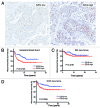EZH2 and ALDH1 expression in ductal carcinoma in situ: complex association with recurrence and progression to invasive breast cancer
- PMID: 23759596
- PMCID: PMC3737307
- DOI: 10.4161/cc.25065
EZH2 and ALDH1 expression in ductal carcinoma in situ: complex association with recurrence and progression to invasive breast cancer
Abstract
The diagnosis of ductal carcinoma in situ (DCIS) is an increasingly common event due to widespread use of screening mammography. However, appropriate clinical management of DCIS is a major challenge in the absence of prognostic markers. Tumor-initiating cells may be particularly relevant for disease pathogenesis; therefore, two markers associated with such cells, EZH2 and ALDH1, were evaluated. A cohort of 248 DCIS patients was used to determine the association of EZH2 and ALDH1 with ipsilateral breast event, DCIS recurrence and progression to invasive breast cancer (IBC). In this cohort, high EZH2 expression was associated with the risk of an ipsilateral breast event and DCIS recurrence but not invasive progression. ALDH1 expression was observed in both the tumor and stromal compartment; however, in neither compartment were ALDH1 levels independently associated with evaluated study endpoints. Interestingly, the combination of high EZH2 with high epithelial ALDH1 was associated with disease progression. Therefore, ALDH1 within the DCIS lesion can add to the prognostic significance of EZH2, particularly in the context of risk of development of invasive disease.
Keywords: ALDH1; DCIS; EZH2; IBC; ductal carcinoma in situ; invasive breast cancer; prognostic markers; tumor-initiating cells.
Figures




Similar articles
-
Prognostic impact of the cancer stem cell related markers ALDH1 and EZH2 in triple negative and basal-like breast cancers.Pathology. 2012 Jun;44(4):303-12. doi: 10.1097/PAT.0b013e3283534bcb. Pathology. 2012. PMID: 22544210
-
Aldehyde dehydrogenase 1 expression correlates with the invasion of breast cancer.Diagn Pathol. 2015 Jun 13;10:66. doi: 10.1186/s13000-015-0301-5. Diagn Pathol. 2015. PMID: 26070788 Free PMC article.
-
Chemokine Signaling Facilitates Early-Stage Breast Cancer Survival and Invasion through Fibroblast-Dependent Mechanisms.Mol Cancer Res. 2018 Feb;16(2):296-308. doi: 10.1158/1541-7786.MCR-17-0308. Epub 2017 Nov 13. Mol Cancer Res. 2018. PMID: 29133591 Free PMC article.
-
Carcinoma in situ of the female breast. A clinico-pathological, immunohistological, and DNA ploidy study.APMIS Suppl. 2003;(108):1-67. APMIS Suppl. 2003. PMID: 12874968 Review.
-
A retrospective alternative for active surveillance trials for ductal carcinoma in situ of the breast.Int J Cancer. 2020 Mar 1;146(5):1189-1197. doi: 10.1002/ijc.32362. Epub 2019 May 8. Int J Cancer. 2020. PMID: 31018242 Free PMC article. Review.
Cited by
-
Bimodal regulation of the PRC2 complex by USP7 underlies tumorigenesis.Nucleic Acids Res. 2021 May 7;49(8):4421-4440. doi: 10.1093/nar/gkab209. Nucleic Acids Res. 2021. PMID: 33849069 Free PMC article.
-
EZH2 protein expression in normal breast epithelium and risk of breast cancer: results from the Nurses' Health Studies.Breast Cancer Res. 2017 Mar 2;19(1):21. doi: 10.1186/s13058-017-0817-6. Breast Cancer Res. 2017. PMID: 28253895 Free PMC article.
-
Putative stem cell markers in cervical squamous cell carcinoma are correlated with poor clinical outcome.BMC Cancer. 2015 Oct 24;15:785. doi: 10.1186/s12885-015-1826-4. BMC Cancer. 2015. PMID: 26499463 Free PMC article.
-
Breast cancer stem cells: A review of their characteristics and the agents that affect them.Mol Carcinog. 2021 Feb;60(2):73-100. doi: 10.1002/mc.23277. Epub 2021 Jan 11. Mol Carcinog. 2021. PMID: 33428807 Free PMC article. Review.
-
JMJD1A promotes tumorigenesis and forms a feedback loop with EZH2/let-7c in NSCLC cells.Tumour Biol. 2016 Aug;37(8):11237-47. doi: 10.1007/s13277-016-4999-9. Epub 2016 Mar 5. Tumour Biol. 2016. PMID: 26945572
References
-
- Allegra CJ, Aberle DR, Ganschow P, Hahn SM, Lee CN, Millon-Underwood S, et al. National Institutes of Health State-of-the-Science Conference statement: Diagnosis and Management of Ductal Carcinoma In Situ September 22-24, 2009. J Natl Cancer Inst. 2010;102:161–9. doi: 10.1093/jnci/djp485. - DOI - PubMed
Publication types
MeSH terms
Substances
Grants and funding
LinkOut - more resources
Full Text Sources
Other Literature Sources
Medical
Miscellaneous
